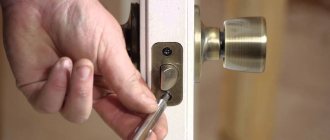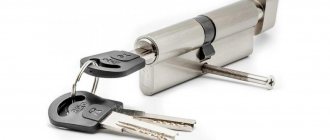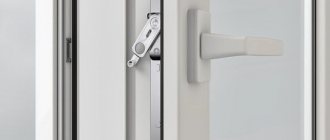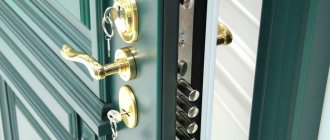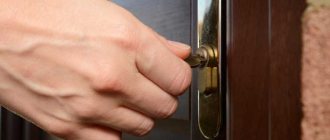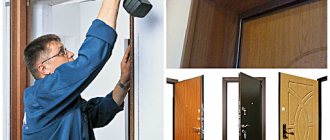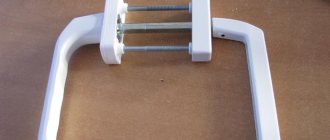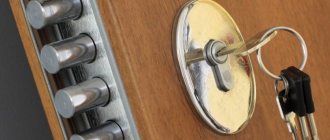Types of door handle breakdowns
It should be noted right away that there are no fundamental engineering differences between the door handles of entrance doors made of metal or wood; there may only be structural reinforcements due to the large weight. For this reason, the moment of inertia increases significantly, and it causes the appearance of large loads during opening/closing of doors. Only push handles are mounted on entrance groups, and we will talk about them in this article.
Lever handles for metal doors
Table. Common door handle breakdowns
| Signs of breakdown | Short description |
| The handle broke off completely | The reason for such a breakdown is poor-quality metal workmanship, and very rarely, excessive loads. High-quality handles can withstand loads of more than one hundred kilograms; such forces are almost never encountered in practice; therefore, they do not break. |
| The handle turns, but the lock mechanism does not respond | Broken inner square in the handle. The reason is the same as in the first case - low-quality metal. By the way, Chinese manufacturers very often use silumin for the manufacture of various accessories. This is an aluminum-based alloy and can contain up to 23% silicon. As a result, physical strength indicators are very low, critically afraid of even minor static loads, under such conditions metal fatigue quickly appears and products crack for no apparent reason. |
| Handle sticks | The element turns with difficulty, the latch does not spring. The most difficult problem is that you will have to disassemble the lock mechanism. |
| The handle turns easily, but the latch does not move | Most often the problem is with the packaging: the thickness of the doors is much greater than the length of the square. It may move to one handle, and the second will completely disengage. |
| The handle does not return to its original position after pressing | There are two reasons: severe jamming due to critical wear of some parts or misalignment, and breakage of the spiral spring. |
Broken door handles are a common problem.
If your handle breaks, in most cases you can fix it without dismantling the lock; it will only take a few minutes. But this time is only for disassembly/assembly, and we must also take into account the time spent on searching and purchasing spare parts.
Find out how to adjust a plastic balcony door with your own hands in a special article on our portal.
Main causes of breakdowns
When using doors, the performance of the locking mechanism is influenced by basic and additional factors. The main ones include:
- frequency of operation;
- efforts made;
- time of use.
As a result of constant loads, physical wear of the metal occurs, which leads to breakage of the spring. Since interior locks are subject to more active impact than the front door mechanism, they fail more often.
This is also facilitated by careless operation, sudden movements, and too much pressure.
Often the cause of a snail's failure is the poor quality of the material used to make it. According to technical requirements, the production of metal for springs is made from special grades of steel:
Step-by-step instructions for replacing a door handle
We will first consider the simplest option, and then focus on the complex type of repair. Initial data: the handle broke off completely and fell to the floor. At the same time, all other details of the castle are in place and, at first glance, do not arouse suspicion.
If the handle breaks off, it cannot be repaired.
First we need to establish the reason for this situation. In our case, the lock is from a very well-known company; the quality of the parts is beyond doubt. The reason is trivial - the installation and configuration of the lock was carried out by irresponsible or illiterate people. When selecting the length of the square rod connecting the handles to the lock, the length was chosen incorrectly. As a result, the element did not enter the body of the handle to the full depth of the hole, as the manufacturer expected, but was held only at the very edge. At this point the handle does not have sufficient strength and breaks off under minor loads.
The cause of failure is insufficient length of the rod
The reason has been clarified; before disassembling the door, buy a rod of the required length in the store (you must first find out the size). To do this, add up the thickness of the metal door and the two depths of the square holes in the handles.
The square rod should protrude from both sides of the door leaf
Buy new pens. It is recommended to change two at once, otherwise the difference will be noticeable. As a result of abrasion, the surface of any product slightly changes its original appearance; if you do not change them at the same time, the door design deteriorates.
Step 1 . Unscrew the decorative cover. It is fixed with small screws to the outer door trim. The lid serves two purposes: it closes the hole in the door and keeps the handle from being pulled out.
First you need to unscrew the decorative cover
Step 2 . Remove the remaining broken piece of handle from the square. It has a large locking washer installed on it. Notice how short the square rod extends from the door; this position caused the handle to break.
The washer and broken part of the rod are also removed
Step 3 . Use wire cutters or pliers to remove the rod. In our case, the Chinese used the cheapest manufacturing option: thin narrow strips were cut from waste sheet iron.
The rod can be easily pulled out with pliers
Step 4. Insert a new square into the hole, check its length. It should protrude from the door by about 3-3.5 cm.
The new rod protrudes beyond the canvas by 3 cm
Step 5 . Replace the handle and screw on the lid. Check the functionality, if everything is normal, then you can remove the tools.
Attaching a new handle
But there are situations when the new square is a little shorter, there is a risk that it will move to one side and the handle will break again. You can fix the problem using small nuts or pieces of metal.
Troubleshooting rod displacement
Now you can begin more complex repairs that require disassembling the mechanism.
Prices for door handles
Door handles
The handle is loose
Due to intensive use or unreliable fastening, the handles may become loose over time. There are several ways to correct the situation:
- When the handle is fixed with a latch, the connection may become loose and to strengthen it, you need to wind a strong thread or sealing tape between the door and the latch. True, this technique gives a short-term effect;
- if the handle is fastened with a pair of bolts or a goujon, then it is enough to tighten the fasteners;
- To tighten the fittings on the thread, you need to hold the handle on one side and twist it clockwise on the other.
Step-by-step instructions for repairing the handle latch
When the door slams, the latch does not retract into the lock and prevents normal closing. If you press the handle, it jams and is difficult to remove; uncharacteristic squeaks are heard. This malfunction requires mandatory repair. The handle latch will not work on its own, and over time the problem constantly gets worse and can cause complete breakdown of the lock.
Sticking handle latch can lead to more serious damage
Removing the handle and lock
Step 1 . Remove the metal door handle strips. They are fastened with long bolts through the entire thickness of the door. To increase the security of the lock, the handle strips are installed so that the bolts are located indoors. The opposite strip has a thread into which the fastener is screwed. There can be two, three or four such hardware; the quantity does not play any role and does not affect the strength and reliability of the lock. These are purely decorative solutions, chosen by manufacturers taking into account the model of the mechanism.
The door handle is held in place by several bolts
Prices for cordless screwdrivers
Cordless screwdriver
Step 2 . Take out the lock core, it is screwed to the locking plate with one long bolt.
The core of the lock is removed
Important. Some cores cannot be removed without a key inserted. The key must not only be inserted, but also turned a little, in this way the cam is removed into place, it becomes in the same plane with the core and is removed from a narrow slot in the mechanism body. Inexperienced craftsmen do not know about this feature and try to pull out the core with great effort. The result is a complete breakdown of the core or body and the need to purchase a new lock.
Step 3 . Unscrew the bolts holding the lock strike plate in the door leaf. Their number may also vary depending on the manufacturer and model. Remove the lock from the door.
The last one to remove is the lock plate.
Next, all work must be done on the table, so cover its surface and protect it from scratches and dirt.
Disassembling the lock
The work requires attentiveness, carefully remember the order, do not lose small bolts and parts. For fastening, it is advisable to prepare a box and put it in it. Inspect the lock, find the side where the bolts are tightened.
This is what a door lock looks like
Step 1 . Place the lock on the table and unscrew the fasteners one by one.
You need to unscrew the lock very carefully so that the lid does not come off abruptly.
Important. Do not rush, do not allow the case cover to open spontaneously. If it is abruptly removed, then there is a high probability that the mechanisms for moving the crossbar will fall apart, and then installing them in their original place in the right order is very difficult. There are locks that are so complex that only the most experienced professionals can do this work, even with a factory key.
Step 2 . Very carefully remove the side cover of the case, carefully inspect and remember the position of all moving elements. Before assembly, they must be installed in exactly the same position.
To properly assemble the lock after lubrication, you must immediately remember the location of the parts in the body
Step 3 . Move the latch with your hand, find the place where it sticks a little. If the problem is long-standing, then critical wear may already appear in this place. Most locks allow some parts to be rotated 180°, due to this the rubbing surfaces change and the functionality of the device is completely restored.
Determining the cause of the jam
Remove the latch from the housing and thoroughly lubricate all rubbing surfaces. You can use traditional grease, but it is better to have a special lubricant for kitchen gas stove taps. It contains graphite powder, it never dries out and guarantees an almost unlimited service life. To make the lock move easier, you can also slightly lubricate the other moving parts of the lock.
All rubbing surfaces are treated with graphite lubricant
Step 4 . Insert the latch into its original position. Carefully check the position of all parts and make sure they move smoothly.
Reassembling the lock is done in the reverse order
Practical advice. Pay attention to the metal used to make Chinese locks, the thickness of the plates, the degree of secrecy, etc. After analyzing what you see, you will lose the desire to buy such products.
Step 5 . Place the side cover and secure its position with screws. All steps must be performed in reverse order.
The cover is secured after checking the smooth movement of the parts.
Step 6 . Reinstall the mechanism. This is a so-called crab lock; it has its own structural differences and a special installation algorithm. The device has additional bolts connected to the lock with special rods. They are located around the perimeter and give the body a crab-like appearance. During installation, it is necessary to achieve such a position of the rods so that their holes coincide with the strips, and the connection becomes working. Inexperienced craftsmen will have to waste a little time: the rods slip off, it is difficult to get to them, and access is limited.
When installing the lock in the door leaf, you need to get the hooks into the holes of the rods
Step 7 . Screw the lock fixing bolts into place and insert the core. Keep in mind that it is asymmetrical; pay attention to the location of the threads on the body and the holes for the fixation bolt.
Installing the lock core
Step 8 . Screw the cap metal handle strips. Do not rush, long bolts do not immediately fall into the threaded sockets. Do not use too much force when tightening the hardware. We have already mentioned that the Chinese use low-quality metal; with great effort, the thread in the bar will break. The bolts should be tightened with your fingers; only a few finishing turns are made with a screwdriver.
Fixing door handles with decorative strips
Assembly is complete. Now we need to check the functionality of the components and the effectiveness of the repairs made. If everything works correctly and without jams, great, you have completed your task. If the problems persist, repeat the repair or buy a new, better quality lock. We advise you to choose the second option, because now you have personal experience of which products you should not purchase.
Components of the mechanism
As the proverb says: “If you don’t know the ford, don’t go into the water.” The same goes for door handles. To be able to repair any of them yourself, you need to have an understanding of its structure. Standard pressure ones consist of the following parts:
- the handle itself;
- latch;
- strip, socket;
- flange;
- removable key;
- core;
- fastening elements.
The set with a handle equipped with a lock includes a cylinder and several spare keys in case they are lost or damaged.
The door design of the knob type consists of an internal rotary handle, a technological hole, a spring clip, and a lock button. In addition, there is a functional shank, a decorative flange, a mounting plate, a locking mechanism cylinder, and an external rotary handle. Don’t forget about the latch mechanism, the plate located at the end of the door and the strike plate for the door frame.
Important ! Due to incompetence in the design of the door handle mechanism, 90% of fatal breakdowns occur. Subsequently, the structure can no longer be restored.
A few words about the mechanism
Before we repair the door handle, let's get acquainted with its mechanism and operating principle. Let's say right away that we are talking about a push handle, since this is what is usually used on entrance doors.
So, the mechanism has the following details:
- The handle is exactly the element that we grasp with our hands and press to open the door;
- Socket - is a round platform in which a movable mechanism and a handle stopper are located. The socket also provides fastening of the entire assembly to the door;
- Decorative overlay - is a ring or square that is screwed onto the rosette;
- Spring - returns the lever to its original position;
- Travel limiter - the name of this part speaks for itself;
- Retaining ring - secures the handle in the socket;
- The square is a square-section axis that transmits the rotational movement to the lock and the counter handle.
Note! Some models of handles, instead of a round rosette, have a long plate-plate, which also serves as a frame for the cylinder or as a place for attaching the lock handle. But, regardless of the platform, the operating principle of its mechanism is always the same.
Thus, when we press the lever, the axis rotates, which drives the lock mechanism. As a result, the latch is pulled out from the striker and the door is unlocked.
What to do if the interior door handle jams: reasons and repair methods
Author of the article: Alexandra Ivanova May 10, 2021
Any product, having outlived its useful life, begins to “delight” its owners with vital moments. Door handles are no exception. The reasons why they fail are as numerous as the types of handles themselves are varied. Therefore, to successfully eliminate breakdowns, it is necessary to study the types of door hardware and the procedure for manipulating them.
How to repair the front door handle?
We use the door handle on the front door every day. It is not surprising that sometimes breakdowns happen to it. If there is a serious problem, it is better to contact customer service. But if the manufacturer does not have such a service, we will tell you how to fix the handle yourself.
We do not recommend repairing door components yourself if the manufacturer's warranty period is still valid. In case of breakdown, contact customer service.
If the entrance handle is just loose, then just tighten the screws with a screwdriver. But often the breakdown turns out to be much more serious. First, let's define the types of input handles.
The handle does not turn the rod
If you press the handle, but the latch does not engage, there may be two reasons for the malfunction:
- The short rod flew out of the core as it moved towards the counter handle;
- The square milling of the core was “slipped off”.
In the first case, you will have to change the square axis to a longer one. Of course, you can temporarily solve the problem by centering the position of the square and fixing it in the handles with locking screws.
However, do not forget that this may cause the handle to break. As we have already said, the axle must go deep into the core.
As for the second case, repairing the front door handle made of silumin makes no sense at all. No matter how you repair it, it will soon break completely and irrevocably.
The only way to temporarily fix the problem is to try to seal the joint, for example, by wrapping electrical tape around the rod. Another option is to make a cut along the rod and widen it a little if there is none initially. You can even insert a small wedge.
But the result will still not last long. In addition, keep in mind that if the rod fits into the silumin core too tightly, the handle may simply crack.
A nuance: you can distinguish a silumin handle from a quality product by its suspicious lightness. In addition, an important indicator is the price - a high-quality pen with a mechanism, even a Chinese one, cannot cost less than 900–1000 rubles.
Troubleshooting methods
So, what to do if the handle breaks? Depending on what exactly caused the breakdown, there are many options for repairing the fittings. The simplest situation is a banal mechanism jamming due to a lack of lubrication. In order to correct the situation, you need to disassemble the handle and lubricate all moving parts. Sometimes it is enough to drop oil on the bolt and turn the handle several times to distribute the substance throughout the mechanism. In this simple way, you can eliminate creaking, jamming when pressed, and also increase the service life of internal parts.
If there is a lack of lubrication, metal parts begin to rub and fail. This is especially dangerous if the lock is clogged, since dust acts as an abrasive.
Also, in some cases, it is enough to tighten the fastening screws and adjust the position of the fittings. This will eliminate loosening and return the parts to the correct position.
In simple cases of door handle breakage, you just need to tighten the fastening screws
How else can you repair a door handle? In order to find out the cause of the malfunction, you first need to disassemble the product. To do this, remove the decorative trims. They are located immediately under the handle and mask the mounting bolts. Just twist the caps a few times and they will come off easily. Then unscrew the bolts and carefully remove the handle itself. The inside of the mechanism will open to you. It is not necessary to remove it.
Pay attention to parts such as the key washer and torsion spring. In order to inspect the washer, it is necessary to free it from the retaining rings. Very often the cause of the malfunction is related to a defect in this particular part. As for the spring, it drives the handle and tongue. If there is a problem with these pieces, check the condition and location of the spring.
If at this stage you were unable to figure out the situation, unscrew the plate at the end of the door and completely remove the mechanism for a more thorough inspection. If broken elements are identified, they must be replaced with new ones and then the handle will work normally again. Be sure to assemble the structure in the same form as it was originally. To avoid confusion when dismantling, lay out the parts in the order in which you removed them from the door.
If the damage turned out to be so serious that you were unable to repair the handle, you can call a technician or immediately replace the product with a new one. True, high-quality models are not so cheap.
Recommended Procedure
Repairing the handle of a push-type interior door is no different from restoring the functionality of analogues installed on entrance doors. All technological operations, as well as typical faults, are completely identical. The only difference is in the nuances determined by the type of locking mechanism (mortise or overhead) and its model (manufacturer).
Removing the locking device
- On both sides of the sash there are fastening strips connected by long screws. Depending on the lock model, there may be 2 or 4 of them. The latter is typical for handles installed on frame doors. The task is to unscrew the hardware and remove them from the mounting sockets.
- All that remains is to remove the locking mechanism. If it has a decorative strip, you will first have to unscrew the small screw that secures the handle. After this (rotating counterclockwise) the cover is removed.
Troubleshooting and repair
One end of the spring flew off its seat. This becomes clear even without disassembling the fittings; with such a defect, after pressing the handle does not return to its original position. It's easy to fix - hook the spring and check the mechanism in operation. But if the part is broken, then it is useless to repair. Firstly, we still need to find it, with the same linear parameters. Secondly, its tensile force must be identical, otherwise the operation of the lock will cause a lot of inconvenience. For example, the tongue will not be completely recessed into the sash, constantly clinging to the bar. In this case, it is advisable to install a new lock.
When purchasing a handle for a metal door, you need to look at the location of the holes in the strip for fasteners. It is unlikely that anyone will be happy with the prospect of drilling a steel sheet if it turns out that the old sockets for fixing the lock are not suitable.
There is no tongue displacement. This mechanism malfunction is caused by several reasons.
Option 1 – the handle itself has become loose. This is mainly typical for samples made of soft metals (alloys). The edges of its groove gradually flare out, and the reliability of the coupling with the rod is lost. There are two ways to solve the problem. The first (temporary, while searching for new fittings) is to seal the gap between the “square” and the groove in the handle. The second is to replace the part. Pens are sold at retail, and you can choose a product of any configuration you like. The main thing is that the landing “socket” is identical in size for reliable docking with the latch mechanism.
Option 2 – pin damage. As a rule, cheap locks have rods made of silumin, but this alloy is no different in strength. It’s easy to buy such a part, cut it to length, file the ends and install it in place.
The handle periodically falls out, but there is no destruction of the metal. The only reason is that the retaining ring is loose or broken. If it bursts, fragments will fall out immediately after dismantling the mechanism. This is the worst scenario - such a lock will have to be changed. If the latch is simply loose, you can try to tighten it. This does not always work out, especially if the steel is of high quality; it springs easily. But there are no other repair options in such a situation. If the result is positive, the lock will still serve for some time.
And one last thing. Do not forget that any mechanism, including the door handle, needs periodic inspection and maintenance. If you partially disassemble the lock in a timely manner, lubricate the rubbing parts, and regularly tighten the fasteners, then there will be no problems with its breakdown for a long time.
It turns out that knowing the locking device and having only a couple of screwdrivers on hand, it is not difficult to understand how to repair the door handle of an interior or entrance door. But if you need to replace some part or the entire mechanism, it is better to take the faulty sample with you when going to the store. You need to purchase an analogue “one to one”, otherwise it is not a fact that it will fit in size, thickness, configuration, and so on.
Rules for repairing major breakdowns
Many home craftsmen know how to repair a door handle spring. To do this, you need to disassemble the lock and replace the part that has become unusable. Such breakdowns are easily eliminated.
- Using a suitable screwdriver or screwdriver, remove the trim pieces from the door leaf.
- Remove the core and carefully disassemble.
- If the “snail” is broken, you need to remove its remains and put a replacement in place. If its edges are bent or it is weakened, replacement is also necessary.
- Having fixed the spring, return all elements to their place and check their functionality.
- After this, return the fittings to their place and secure them.
If the handle is old, it is recommended to lubricate its moving and rubbing parts with grease. Solid oil and graphite lubricant are suitable.
It is important to ensure that no parts are lost or dirt gets into the mechanism, otherwise the return mechanism will not function normally.
Knowing these features, you can fix the breakdown yourself in a short time and without significant financial costs.
In households, repairing door handles is a standard procedure. Sooner or later, any mechanism can fail, especially if it is actively used for a long time. If a door handle fails, it is not necessary to immediately replace it with the entire set of parts. There are many ways to quickly fix a door handle on an interior door.
Door handle repair depending on the type of fault
It happens that locks stop working on interior or exterior doors at the most unexpected moment. You can find a way to repair it only by determining the type of malfunction.
If the mechanism is stuck
This problem occurs more often not because the lock core has failed, but because the door itself was incorrectly configured or inserted into the frame incorrectly. You can determine what is preventing the mechanism from closing correctly with the door open by pressing the handle. If in this position the handle and bolt work normally, then the reason is a malfunction of the locking plate. The solution to the problem is as follows:
Over time, incorrect installation of the handle will certainly lead to breakage of the locking bolt PHOTO: mirzamkov-krasnodar.ru
If the problem is not with the locking plate, then you need to do the following:
It happens that the lack of lubricant affects the performance of the door handle. A simple spray of machine oil or other industrial grease will help correct sticking.
If a key is installed on the opposite side of the well, then it is not always possible to open the door PHOTO: psk-remont.ru
The handle falls out of the door socket
The retaining ring, which is a mandatory part of the door lock, tends to pop out. This situation can be observed after hitting the door or slamming it hard.
Too short a lock tongue can also cause a malfunction. PHOTO: leroymerlin-catalog.biz
Such a ring can be inserted into place if it is intact. In case there are cracks or other defects, it is changed. It can be purchased at a hardware store or simply replaced with a washer. If it does not fit the size a little, bend it with pliers so that it presses the core well.
Door handle spring broken
As a rule, such a small part needs replacement. Its breakdown can be caused by careless handling of the door handle. To repair it, you should disassemble the fittings to the core, remove the top washer and look at the condition of the spring.
According to statistics, door handles can withstand greater loads than the structure itself PHOTO: remont-moroz.ru
It happens that it just slips off and does not have any special defects. She is returned to her place. If there is any damage to the structure, it must be replaced. If the spring is difficult to remove from the grooves, it means that it is intact, and the breakdown is something else.
The lever does not return after pressing
If the handle refuses to return, the problem may be due to a dysfunctional door handle return spring. To check this, you need to dismantle the fittings. To do this, remove the core from the socket and remove the spring from the inside.
The absence of a reverse push may be due to too strong pressing PHOTO: 1obl.ru
After that, install the new one in place and fix the stop so that the spring remains inside.
There is no turning of the rod in the door handle
The lock problem can be associated with two factors: a licked milled square or the rod simply jumped out of the core. To eliminate the cause, it is necessary to disassemble the structure. If there is a core defect, it is better to immediately replace it with a new one.
The breakage of the handle may be due to the fact that it protrudes much from the opposite side PHOTO: youla.ru
As for the licked square, you can temporarily wrap electrical tape around the axle. This creates a more efficient engagement between the two parts.


